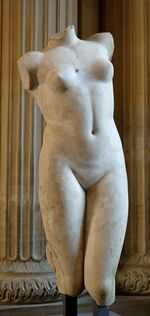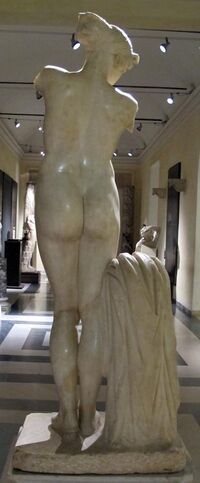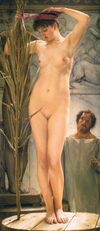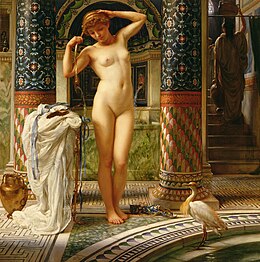Biology:Esquiline Venus
The Esquiline Venus, depicting the goddess Venus (i.e. Greek Aphrodite), is a smaller-than-life-size Roman nude marble sculpture of a female in sandals and a diadem headdress. It is widely viewed as a 1st-century AD Roman copy of a Greek original from the 1st century BC. It is also a possible depiction of the Ptolemaic ruler Cleopatra VII.
The sculpture is thought to have been based on an original Hellenistic statue from the Ptolemaic Kingdom. It possibly depicts Venus-Isis, a syncretism of Venus with the Egyptian goddess Isis. The copy was likely commissioned by emperor Claudius to decorate the Horti Lamiani.[1] The vase depicted next to the female figure includes an asp or uraeus, depictions of the Egyptian cobra.[2]
History
In style the Esquiline Venus is an example of the Pasitelean "eclectic" Neo-Attic school, combining elements from a variety of other previous schools - a Praxitelean idea of the nude female form; a face, muscular torso, and small high breasts in the fifth-century BC severe style; and pressed-together thighs typical of Hellenistic sculptures.[3] Its arms must have broken off when the statue fell after the imperial park in which it stood fell into neglect after antiquity. They have been frequently restored in paintings (see below), but never in reality.
Subject
</ref> and reportedly dressed as Aphrodite when meeting Mark Antony at Tarsos in 42 BC.[4]
In modern art
The sculpture inspired many artistic reconstructions in the decade after its discovery. Chief among these are Sir Lawrence Alma-Tadema's A Sculptor's Model (1877) and Edward Poynter's Diadumene (1884).[5] These both portrayed the statue's model binding her hair with a strip of fabric (as with the statue type diadumenos) in preparation for modelling for the sculptor or for taking a bath respectively. Poynter believed this to be the correct reconstruction partly because the remains of the little finger of her left hand are visible on the back of her head, suggesting that her left arm was raised to hold her hair in place, whilst the right hand wound the fabric. At the Museo Centrale Montemartini, the Esquiline Venus is now usually displayed behind a 'pool' (actually a glass floor panel) in tribute to this rendering.

Exhibitions
From December 2006 to February 4, 2007, the sculpture was the centrepiece of the exhibition "Cleopatra and the Caesars" at the Bucerius Kunst Forum at Hamburg,[7] following which, from March to June 2007, she was at the Louvre for the Praxiteles exhibition.
Notes
- ↑ For bibliography on this point, see here.
- ↑ For bibliography on this point, see here.
- ↑ Robinson: "the Esquiline Venus is an anomalous work, for while the body is modelled with a voluptuousness that almost oversteps the line dividing the nude from the naked, the head is treated with archaic severity, in the style of the first half of the fifth century", quoted in Edmund von Mach, A Handbook of Greek and Roman Sculpture 1905, plate 318 and p 348f.
- ↑ Burstein, Stanley M. (2004), The Reign of Cleopatra, Westport, CT: Greenwood Press, p. 23, ISBN 9780313325274, https://archive.org/details/reignofcleopatra00burs/page/23.
- ↑ Poynter worked from the cast of the original in the Sculpture Court of the Victoria and Albert Museum, according to the reviewer in Blackwood's Edinburgh Magazine, "The Decline of Art: the Royal Academy and Grosvenor Gallery", July 1885, in an extended justification of nudity in art: "Slightly, however, he has seen fit to modify the head: archaic curls are relaxed into flowing locks, and severe features relent into society smiles" (p. 13).
- ↑ Later, 2nd century Parian marble torso of this type, from Brindisi [1]
- ↑ "Bucerius Kunst Forum". http://www.buceriuskunstforum.de/english/14/index.php?pu=1.
References
- Mary Beard, 'Archaeology and Collecting in late-nineteenth century Rome', from exhibition catalogue to the Royal Academy exhibition "Ancient Art to Post-Impressionism - Masterpieces from the Ny Carlsberg Glyptotek, Copenhagen"
- Charles Waldstein, 'Pasiteles and Arkesilaos, the Venus Genetrix and the Venus of the Esquiline', The American Journal of Archaeology and of the History of the Fine Arts, Vol. 3, No. 1/2 (Jun., 1887), pp. 1–13
Cleopatra?
- Das Gesicht der Göttin., 16.10.2006, Der Spiegel. Hamburg 2006, 42, S. 181
- Berthold Seewald, So sah Kleopatra wirklich aus, Die Welt, 26 October 2006 (in German)[2]
- Bernard Andreae, Dorothea Gall, Günter Grimm, Heinz Heinen et al., "Kleopatra und die Caesaren", hrsg. von Ortrud Westheider, Karsten Müller (2006: Munich, Hirmer Verlag)
- Cleo Uncovered (exhibition review of "Cleopatra and the Caesars"), Current World Archaeology 20, pages 42–43
External links
- 3D model of the Louvre's Esquiline torso via photogrammetric survey
- Buffalo - more images, including back view
- Exposed: The Victorian Nude: Room guide: Classical statues - Tate
- Indiana - images (specifically here and here).
 |




